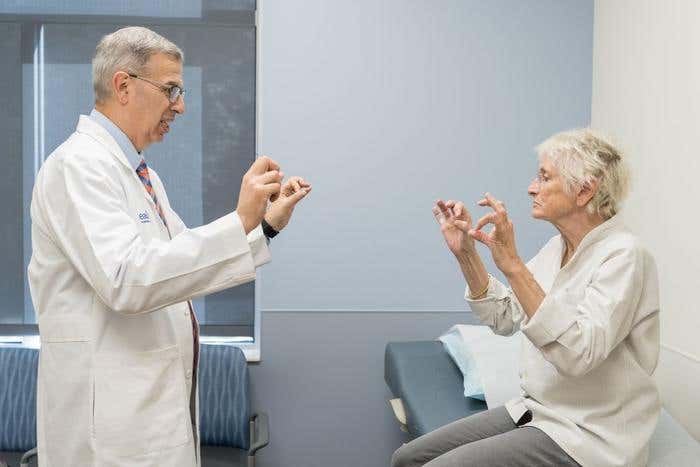New video test uses AI to revolutionize Parkinson’s disease treatment
Breakthrough video-processing technique, utilizing AI, promises to help neurologists better track Parkinson’s disease progression

A patient performs the the finger-tapping test with Michael Jaffee, M.D., chair and professor of neurology at the University of Florida. (CREDIT: UF Health)
A breakthrough video-processing technique developed at the University of Florida, utilizing artificial intelligence, promises to help neurologists better track Parkinson’s disease progression in patients, ultimately enhancing their care and quality of life.
This system, the brainchild of Dr. Diego Guarin, an assistant professor at UF's College of Health and Human Performance, employs machine learning to analyze videos of patients performing the finger-tapping test. This standard test for Parkinson’s involves tapping the thumb and index finger together quickly ten times.
“By studying these videos, we could detect even the smallest alterations in hand movements that are characteristic of Parkinson’s disease but might be difficult for clinicians to visually identify,” Guarin explains. “The beauty of this technology is that a patient can record themselves performing the test, and the software analyzes it and informs the clinician how the patient is moving so the clinician can make decisions.”
Parkinson’s disease is a brain disorder affecting movement, causing symptoms like slowness, tremors, stiffness, and balance issues. Symptoms start gradually and worsen over time. There isn’t a specific lab or imaging test to diagnose Parkinson’s, so clinicians rely on exercises and maneuvers to identify and evaluate its severity.
The Movement Disorder Society-Unified Parkinson’s Disease Rating Scale is the most used tool to follow Parkinson’s progression. However, Guarin notes that despite its reliability, this 5-point scale has limitations in tracking subtle changes and is prone to subjective interpretations.
Related Stories
To address this, the research team, including UF neurologists Dr. Joshua Wong, Dr. Nicolaus McFarland, and Dr. Adolfo Ramirez-Zamora, devised a more objective way to quantify motor symptoms. They used machine learning algorithms to analyze videos and capture nuanced changes over time.
“We found that we can observe the same features that clinicians are trying to see by using a camera and a computer,” Guarin says. “With help from AI, the same examination is made easier and less time-consuming for everyone involved.”
The automated system has also unveiled previously unnoticed movement details, such as the speed at which a patient opens or closes their fingers and how these properties change with each tap.
“We’ve seen that with Parkinson’s, the opening movement is delayed compared to healthy individuals,” Guarin shares. “This is new information that is almost impossible to measure without the video and computer, showing the technology can better characterize how Parkinson’s affects movement and provide new markers to evaluate therapy effectiveness.”
To perfect this system, originally designed to analyze facial features for other conditions, the team utilized UF’s HiPerGator, one of the world’s largest AI supercomputers, to train some models.
“HiPerGator enabled us to develop a machine learning model that simplifies the video data into a movement score,” Guarin explains. “We used HiPerGator to train, test, and refine different models with large amounts of video data, and now those models can run on a smartphone.”
Dr. Michael S. Okun, director of the Norman Fixel Institute and medical advisor for the Parkinson’s Foundation, believes these automated video-based assessments could be transformative for clinical trials and care.
“The finger-tapping test is one of the most critical elements used for diagnosis and for measuring disease progression in Parkinson’s,” Okun says. “Today, it takes an expert to interpret the results, but what is transformative is how Diego and three Parkinson’s neurologists at the Fixel Institute were able to use AI to objectify disease progression.”
Besides placing this technology in the hands of neurologists and other care providers, Guarin is collaborating with UFIT to develop a mobile app. This app will enable individuals to assess their disease over time from home.
Note: Materials provided above by the The Brighter Side of News. Content may be edited for style and length.
Like these kind of feel good stories? Get the Brighter Side of News' newsletter.
Rebecca Shavit
Science & Technology Journalist | Innovation Storyteller
Based in Los Angeles, Rebecca Shavit is a dedicated science and technology journalist who writes for The Brighter Side of News, an online publication committed to highlighting positive and transformative stories from around the world. With a passion for uncovering groundbreaking discoveries and innovations, she brings to light the scientific advancements shaping a better future. Her reporting spans a wide range of topics, from cutting-edge medical breakthroughs and artificial intelligence to green technology and space exploration. With a keen ability to translate complex concepts into engaging and accessible stories, she makes science and innovation relatable to a broad audience.



